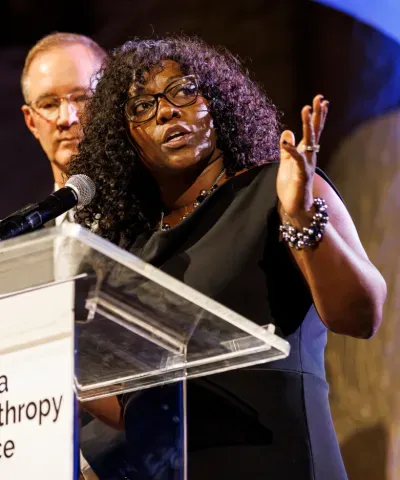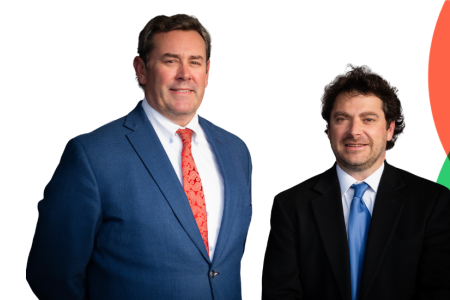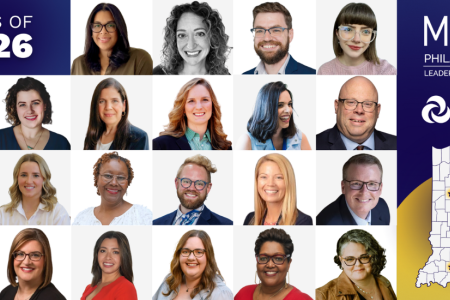DEI by Any Other Name Would Smell as Sweet
Eric Hessel of the Community Foundation of Hendricks County reflects on how shifting language around diversity and inclusion should not distract philanthropy from removing barriers, elevating underrepresented voices, and ensuring all communities have access to opportunity.

Strip away the buzzwords like DEI, belonging, and equity. The truth is, if we abandon this work, we abandon our mission. A community foundation that ignores equity isn’t just out of touch; it’s complicit in the very disparities we exist to dismantle.
In January, Governor Mike Braun signed an executive order eliminating diversity, equity, and inclusion (DEI) initiatives across Indiana’s state government. The order disbanded the Office of Equity, Inclusion, and Opportunity and replaced DEI initiatives with a new framework—Merit, Excellence, and Innovation. While this framing suggests a neutral focus on merit, it implicitly undermines the qualifications of marginalized groups. These so-called meritocracies have historically and consistently excluded highly qualified candidates from these communities. While this move has sparked debate across the state, for those of us working in philanthropy and community development, it is clear that our work is more important than ever.
This shift is not isolated to Indiana. Across the country, the federal government has begun to blatantly retreat from its DEI commitments, rolling back policies, disbanding advisory councils, and slashing funding for programs that support historically underserved communities. In Indiana, the 2025 legislative session brought sweeping budget cuts, including vital support for Indiana’s childcare resource and referral network and the Spark Learning Lab. These cuts will dramatically impact low-income and under-resourced communities, as well as halt the major progress our community has made in raising awareness of the importance of affordable, high-quality childcare for Hendricks County residents.
"It’s about ensuring that a child growing up in Lizton has the same access to opportunity as one in Plainfield, in the same way a child growing up in Gary has the same access to opportunity as one in Carmel."
Governor Braun’s executive order may have declared the end of DEI in state agencies, but it cannot erase the lived experiences of marginalized communities or the data that underscores persistent disparities. In philanthropy, we are not bound by political cycles. Our mission is long-term. We build thriving, inclusive communities where every person has the opportunity to succeed. DEI is not about preferential treatment. It’s about removing barriers. It’s about ensuring that a child growing up in Lizton has the same access to opportunity as one in Plainfield, in the same way a child growing up in Gary has the same access to opportunity as one in Carmel. It’s about recognizing that equity is not a zero-sum game, but a rising tide that lifts all boats.
"...that means bridging the rural-urban divide and addressing disparities between rich and poor."
Inclusive leadership means creating space for voices that have been historically excluded. It requires cultural humility and a willingness to listen, learn, and adapt. We recognize that diversity includes not only race, gender, and ability, but also geography and class. In Indiana, that means bridging the rural-urban divide and addressing disparities between rich and poor. No matter the terminology, the principles of diversity, equity, and inclusion remain essential to fulfilling our mission.
We are intentionally shaping our board and committees to reflect not only our community of today, but also the community we anticipate serving in the next decade. If our focus is limited to the present, we risk falling behind the evolving needs of our future community. This includes recruiting leaders with lived experience, not just institutional credentials. Diverse leadership leads to better decision-making, deeper trust, and more responsive grantmaking.
"This disconnect between demographic reality and civic engagement underscores the urgency of our work."
Hendricks County is one of the fastest-growing counties in the state, projected to grow by 30% over the next two decades. Yet, DEI was ranked only 11th in our most recent Community Needs Assessment, and nonwhite residents were underrepresented in the survey despite targeted outreach. This disconnect between demographic reality and civic engagement underscores the urgency of our work.
We are committed to directing resources to new and new-to-us organizations led by and serving Black, Latinx, Indigenous, LGBTQ+, those with disabilities, rural, and at-promise communities. Of all philanthropic dollars in the U.S.:
- Less than 1% support Black communities;
- Only 7% support BIPOC-led organizations;
- Just 1.9% support organizations serving women and girls; and,
- A mere 0.3% support LGBTQ+ organizations.
These numbers don’t lie. Philanthropy doesn’t reflect the diversity of our nation; we reinforce its disparities. In a country where marginalized communities make up a growing majority, this kind of funding imbalance isn’t just inequitable; it’s indefensible.
"Equity is not a program; it’s a practice."
Equity is not a program; it’s a practice. And for community foundations, that practice must include making our institutions more accessible to those who have not traditionally had a seat at the table. Here are six actionable steps we are taking to open doors and build trust, and we encourage others to join us:
- Simplifying the Grant Application and Reporting Process
- Sharing the Burden of the Application Process
- Providing Flexible, Unrestricted Funding
- Diversifying Decision-Making
- Building Relationships, Not Just Transactions
- Supporting Community Partners Outside the Grant Check
These steps reflect a shift from charity to solidarity, from gatekeeping to bridge-building.
To our fellow funders, nonprofit partners, and civic leaders: now is not the time to retreat. It is time to double down. The dismantling of DEI in government and the erosion of federal support for vital local programs make our role even more essential. We must be the bridge where others build walls. We must be the voice when others fall silent.
To the communities we serve: we see you. We hear you. And we are with you. Our commitment to equity is not a trend—it is a promise.
"...the goal is to build a more just, accessible, and thriving Hendricks County and Indiana for all."
While the language around DEI may evolve, the heart of the work remains unchanged. Whether we call it equity, inclusion, or community-centered leadership, the goal is to build a more just, accessible, and thriving Hendricks County and Indiana for all. DEI by any other name would smell as sweet because it is not the label that matters, but the impact we create together.

This article was written by a Mutz Philanthropic Leadership Institute class member. The institute is focused on building Indiana’s talent pipeline of senior professionals and board members within foundations and corporate giving programs.
explore the mutz institute



